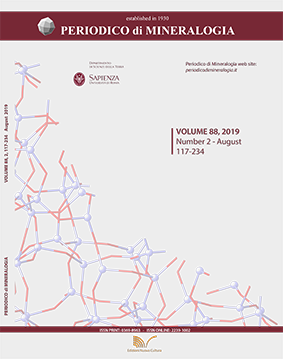Occurrence, Mineral chemistry and origin of Dumortierite in Ali Javad Porphyry Cu-Au Deposit, Sheivar Dagh Alteration System, NW Iran
DOI:
https://doi.org/10.2451/2019PM869Keywords:
Dumortierite, Argillic Alteration, Ali Javad porphyry, Mineral chemistry, FTIR.Abstract
Dumortierite appears as massive aggregates with distinct blue colour in the advanced argillic and silicified zones of the Ali Javad porphyry Cu-Au deposit in the Sheivar Dagh area, NW Iran. Based on field and petrographic observations, this mineral is formed at the latest stages of the hydrothermal activities as a late mineralization phase. Dumortierite is studied here to constrain its potential for characterizing mineralization and prospecting of the Cu-Au porphyry deposit. Chemistry of dumortierite is studied for the first time in a Cu-Au porphyry system and is compared with other examples from the world. This mineral is formed within the subvolcanic dacite to quartz monzonite rocks of the Ali Javad area. A multidisciplinary approach including petrography as well as XRD, ICP-MS, FTIR and EMP analyses was used to characterize the dumortierite samples. The results of this study show that formation of Mg-poor dumortierite is strictly related to the magmatic-hydrothermal system of the Ali Javad porphyry deposit. As Sheivar pluton was crystallizing, light elements including boron were accumulated in the aqueous hydrothermal fluids, which invaded the overlying volcanic rocks and produced vast alteration zones and dumortierite crystallization.


